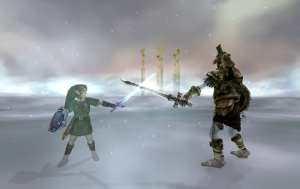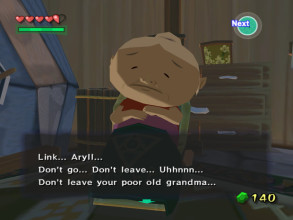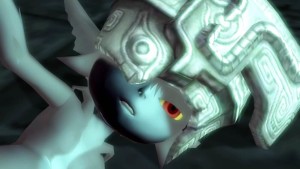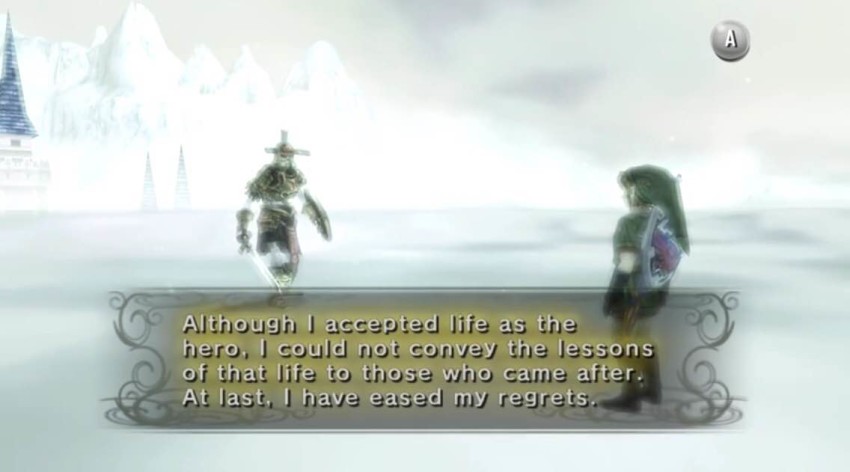Piece of Heart: Heartaches and Sick Days
Posted on May 22 2015 by Alexis S. Anderson
 Welcome to the twelfth and final installment of Piece of Heart, where we look at The Legend of Zelda series through the eyes of a literary professor and examine how its literary elements enhance the gaming experience. This week’s lesson is titled “It’s Never Just Heart Disease… And Rarely Just Illness.” We’re going to take a step away from the weather in setting, to look at the weather in one’s soul. A disease of the heart is almost always caused by emotional or social decay, and all illnesses in literature harbor underlying meditations on character or society.
Welcome to the twelfth and final installment of Piece of Heart, where we look at The Legend of Zelda series through the eyes of a literary professor and examine how its literary elements enhance the gaming experience. This week’s lesson is titled “It’s Never Just Heart Disease… And Rarely Just Illness.” We’re going to take a step away from the weather in setting, to look at the weather in one’s soul. A disease of the heart is almost always caused by emotional or social decay, and all illnesses in literature harbor underlying meditations on character or society.
Illnesses are rarely named in Zelda, though they’re usually caused by a curse or something of that sort. However, we’ve had antagonists die from shots through the heart, and we’ve even had a case of amnesia. So let’s pick apart the symptoms that our dear characters exhibit, and make informed literary diagnoses!
Illnesses, especially those of the heart, are perfect fodder for metaphors in literature. When a heart disease is employed it is often the result of emotional turmoil; heart pains can reflect a dangerous love, lack of determination, or loneliness among a myriad of other emotions, or on a broader scale it can reflect a problem “at the heart of things” in society. Miscellaneous diseases in literature have to be rather mysterious in origin, picturesque, and have strong symbolic possibility. Long deteriorating diseases are popular such as tuberculosis, at one time AIDS, and the modern contender would likely be ebola. Symbolically these diseases can show the decay of society or the effects of long-time oppression; ultimately illness can be moral, social, intellectual, or political.
Much of the Zelda series’ illness can be found in Twilight Princess, which makes sense due to the game’s emphasis on character development. In terms of heart disease, both the Hero’s Shade and Ganondorf exhibit symptoms. The very first Hidden Skill the Hero’s Shade teaches Link is the Ending Blow, an aerial move in which Link thrusts his sword through an opponent’s heart, effectively ending its life. This is important because it expresses the Shade’s regret in not having been able to vanquish evil in his own time. This strike at the heart embodies all of his lost hopes and everything he loved, but wasn’t able to save.
Ganondorf’s symptoms are pretty pronounced, as they primarily consist of a sword through the chest. The first time Ganondorf receives his scar (which remains for two Smash Bros. games mind you) is when the Sages try to destroy him, and he is again pierced in the same spot by Link to end the final battle. In my mind, this damage to the heart reflects Ganondorf’s warped desires– he had an evil heart. This negative affliction couldn’t be destroyed by the Light Sword because of just how dark Ganondorf’s love of chaos and conquest was. Only a Hero with a pure heart could yield the master sword, and only a perfectly contrasting soul could in the end defeat Ganondorf and truly purge his heart of evil.
 We’ll take a brief break from Twilight Princess to take a look back at Link’s Grandma from The Wind Waker, whom we talked about in the very first installment of this series. See Link’s Grandma was left entirely alone after Link went to save his kidnapped sister; she was already hyper-aware of Link’s growing up, it having been his coming-of-age birthday at the start of the game, so this sudden departure of her grandchildren right when she had begun to appreciate them the most shocked her into a deep depression. Depression is a good literary illness, its causes aren’t usually clear-cut and it kills slowly. Seen as jovial before the incident, Grandma’s pain is visible to players. Symbolically the illness is one of atmospheric significance as we see that the Grandma’s world revolved around those kids, and because evil is beginning to encroach upon the lands of the Great Sea, hope and life are being smothered in its wake.
We’ll take a brief break from Twilight Princess to take a look back at Link’s Grandma from The Wind Waker, whom we talked about in the very first installment of this series. See Link’s Grandma was left entirely alone after Link went to save his kidnapped sister; she was already hyper-aware of Link’s growing up, it having been his coming-of-age birthday at the start of the game, so this sudden departure of her grandchildren right when she had begun to appreciate them the most shocked her into a deep depression. Depression is a good literary illness, its causes aren’t usually clear-cut and it kills slowly. Seen as jovial before the incident, Grandma’s pain is visible to players. Symbolically the illness is one of atmospheric significance as we see that the Grandma’s world revolved around those kids, and because evil is beginning to encroach upon the lands of the Great Sea, hope and life are being smothered in its wake.
Back to Twilight Princess! The absolute best example of an illness in Zelda is hands down Ilia’s amnesia. Not only is it an illness known in the real world, but it’s somewhat an ironic usage of illness. Ilia can’t remember anything about her past, however everyone– and I mean everyone –can remember her. The entire town of Ordon is worried sick about her, especially her father and apparently Link. Every person Ilia meets after she’s taken from Ordon remembers her vividly as well; Impaz, Doctor Borville, Prince Ralis, Telma, Renado, yet all this time she doesn’t know her own name. This illness wasn’t to show decay, rather it was to call attention to the the power of an individual. No matter who someone is and no matter the circumstances, he or she can make a difference; every person is immensely important and every person has potential. This coincides with the Twilight Princess principle I mentioned earlier of fully developing every character.
 It would be a crime if I didn’t talk about Midna’s Desperate Hour here; when Zant zapped her twilit body full of light, she started fading fast. Whatever her illness, it made her shine beautifully and was very mysterious in nature. Midna has always been a bit cold to Link, she was using him only to advance her own agenda. But at this moment she denounced the idea that the light world was a harsh place full of oppressors and plead for Zelda to tell Link where to find the Mirror of Twilight. Realizing that Midna had seen the light, Zelda decided to sacrifice herself to save Midna’s life, “Midna… I believe I understand now just who and what you are… Despite your mortal injuries, you act in our stead… These dark times are the result of our deeds, yet it is you who have reaped the penalty. Accept this now, Midna. I pass it to you…” Midna’s illness was transformative, she became a creature of the light if only for an hour, and her heart changed. Her illness was also in contrast to the goings-on of the game itself, the world was being enveloped in darkness while the literal Princess of Twilight was filled to the brim with light.
It would be a crime if I didn’t talk about Midna’s Desperate Hour here; when Zant zapped her twilit body full of light, she started fading fast. Whatever her illness, it made her shine beautifully and was very mysterious in nature. Midna has always been a bit cold to Link, she was using him only to advance her own agenda. But at this moment she denounced the idea that the light world was a harsh place full of oppressors and plead for Zelda to tell Link where to find the Mirror of Twilight. Realizing that Midna had seen the light, Zelda decided to sacrifice herself to save Midna’s life, “Midna… I believe I understand now just who and what you are… Despite your mortal injuries, you act in our stead… These dark times are the result of our deeds, yet it is you who have reaped the penalty. Accept this now, Midna. I pass it to you…” Midna’s illness was transformative, she became a creature of the light if only for an hour, and her heart changed. Her illness was also in contrast to the goings-on of the game itself, the world was being enveloped in darkness while the literal Princess of Twilight was filled to the brim with light.
I thought it fitting to end Piece of Heart on a chapter about heartbreak. I’ve had a wonderful time writing these articles, but all good things must come to an end. I now have a greater appreciation for these games and better resonate with different aspects of them because of these literary-professor-eyes. I really hope that these lessons have helped you readers see the games in a new light and maybe see literature and other media differently as well. There are chapters that I did not cover, if you’d like to see those or learn all of these lessons from the same person I did, then I suggest you read How to Read Literature Like a Professor by Thomas C. Foster.
Parting is such sweet sorrow… What did you think of our final lesson? Do you agree or disagree with the sentiments expressed here? Are there any heartaches or sick days I neglected to mention? How did you like this series as a whole, and would you like to see similar content on Zelda Dungeon in the future? Pour your heart out in the comments, and for old time’s sake feel free to provide illness analyses of your own below!

Alexis S. Anderson is a Senior Editor at Zelda Dungeon who joined the writing team in November, 2014. She has a JD from the UCLA School of Law and is pursuing a career in Entertainment and Intellectual Property Law. She grew up in the New Jersey suburbs with her parents, twin brother, and family shih-tzu.




